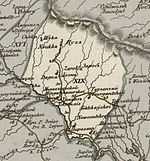Shaki Khanate
| Khanate of Shaki | |||||
| Şəki xanlığı | |||||
| |||||
|
| |||||
| Capital | Shaki | ||||
| Languages | Persian , Azerbaijani | ||||
| Government | Feudalism | ||||
| Khan | Haji Chalabi Khan | ||||
| Historical era | Interwar period | ||||
| - | Establishment | 1743 | |||
| - | Abolished within Russian Empire | 1819 | |||


Shaki khanate (Azerbaijani: Şəki xanlığı, also spelled as Sheki khanate, Shekin khanate, Shakki khanate) was an Azerbaijani khanate on the territory of modern Azerbaijan between 1743 and 1819 with its capital in the town of Shaki.[1]
History
The khanate was founded in 1743 as a result of revolt led by Haji Chalabi Khan against Safavid Empire.[2] It was considered one of the strongest feudal states in Caucasus. The capital of the khanate Shaki, the most populated settlement in the state, was destroyed by floods in 1772, subsequently leading to suburbanization of the town and re-population of the country side.[3] Starting from the end of the 18th century, Shaki khans sought military assistance from the Russian Empire due to growing tensions with Qajars. In 1805, Mustafa Salim Khan signed a treaty with Alexander I of Russia effectively making Shaki Khanate Russian vassal state which was later affirmed by the Russo-Persian Treaty of Gulistan in 1813.[3] In 1819, Shaki Khanate was officially abolished and transformed into a Russian province subordinate to the Russian military administration. In 1840, it was renamed to Shaki Uyezd of Caspian Oblast. In 1846, the province was incorporated into Shemakha Governorate, in 1859 into Baku and in 1868 into Elisabethpol Governorate.[2][3] After establishment of Azerbaijan Democratic Republic in May 1918, Shaki was part of Ganja province and with establishment of Soviet rule in Azerbaijan, Shaki was incorporated into Azerbaijan SSR on May 5, 1920.[3][4]
Geography
The khanate was subdivided into 8 districts headed by khan's naibs. The seat of the head of state was in the capital Shaki, in the Palace of Shaki Khans, which is one of the tourist attractions in present-day Azerbaijan. It was built circa 1761 by the grandson of Haji Chalabi, Huseyn Khan.[5] The palace of the Shaki khans is considered one of the important historical monuments in Azerbaijan.[6] Agriculture was the basis of Shaki Khanate's economy. The khanate was known for silkworming culture, one that is still practised today.[2] Located on the left bank of the river Kish, the town of Shaki was originally sited lower down the hill. However Shaki was moved to its present location after a devastating mud flood in 1772. As the new location was near the village of Nukha, the city became also known as Nukha, until 1960 when it reverted to the name Shaki, after the Scythians.
Rulers
- 1743-1755 Haji Chalabi Khan
- 1755-1759 Aghakishi Beg
- 1759-1780 Mahammadhuseyn Khan
- 1780-1783 `Abd al-Qadir Khan
- 1783-1795 Mahammadhasan Khan (first time)
- 1795-1797 Salim Khan (first time)
- 1797-1802 Mahammadhasan Khan (second time)
- 1802-1806 Salim Khan (second time)
- 1806-1814 Jafargulu Khan Donboli
- 1814-1819 Ismayil Khan Donboli
References
http://www.baldhiker.com/2012/12/24/azerbaijan-sheki-kahns-palace/
- ↑ Swietochowski, Tadeusz (2004). Russian Azerbaijan, 1905-1920: The Shaping of a National Identity in a Muslim Community. United Kingdom: Cambridge University Press. p. 4. ISBN 0-521-52245-5. Retrieved 2011-01-25.
- ↑ 2.0 2.1 2.2 "Большая советская энциклопедия. Шекинское ханство" [Great Soviet Encyclopedia. Shaki Khanate]. Retrieved 2011-01-25.
- ↑ 3.0 3.1 3.2 3.3 "Şəki Şəhərinin Tarixi" [History of Shaki (Executive Power)]. Retrieved 2011-01-25.
- ↑ McLachlan, Keith Stanley (1994). The Boundaries of Modern Iran. UCL Press. p. 28. ISBN 978-1-85728-125-5.
- ↑ "Şəki Xan Sarayı" [Shaki Khan's Palace]. Retrieved 2011-01-25.
- ↑ The Middle East. Library Information and Research Service.
See also
| Wikimedia Commons has media related to Azerbaijani Khanate of Sheki. |